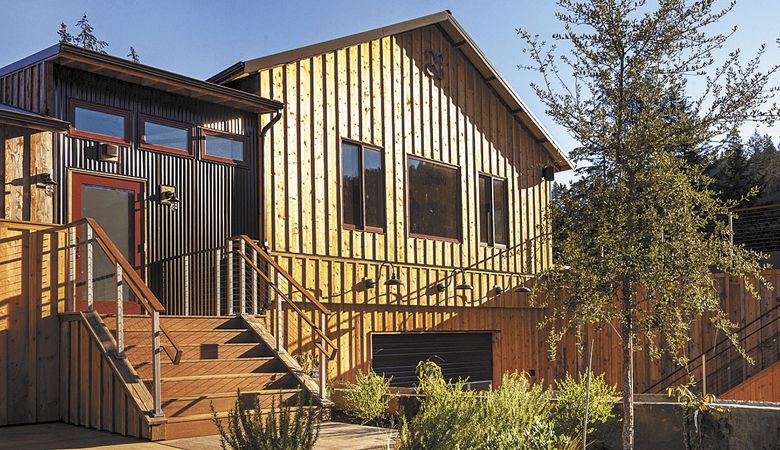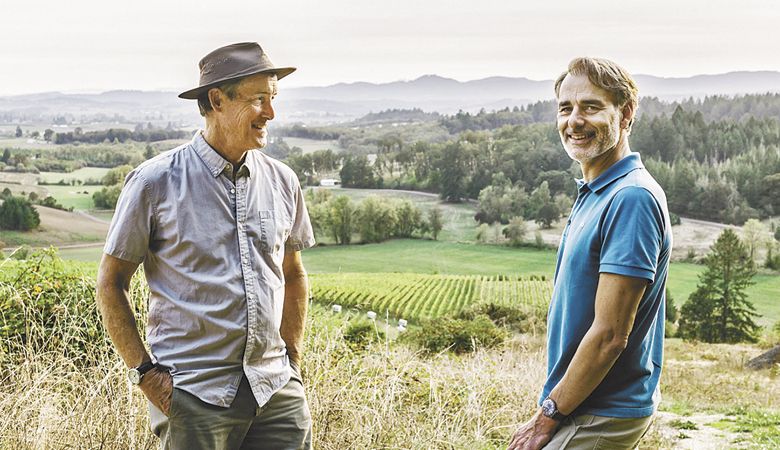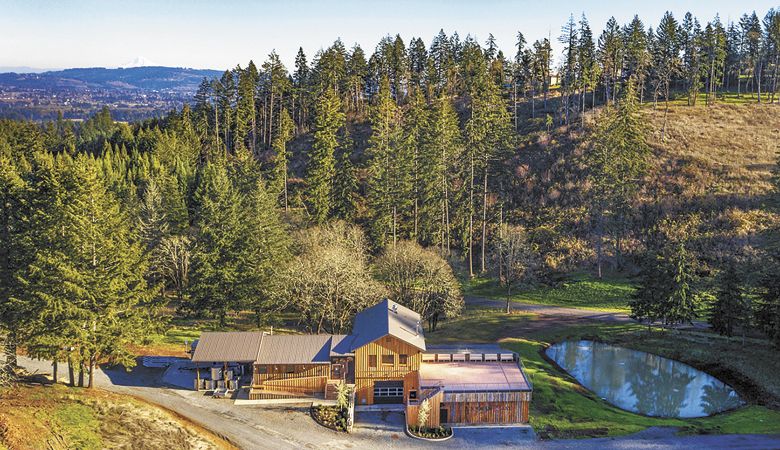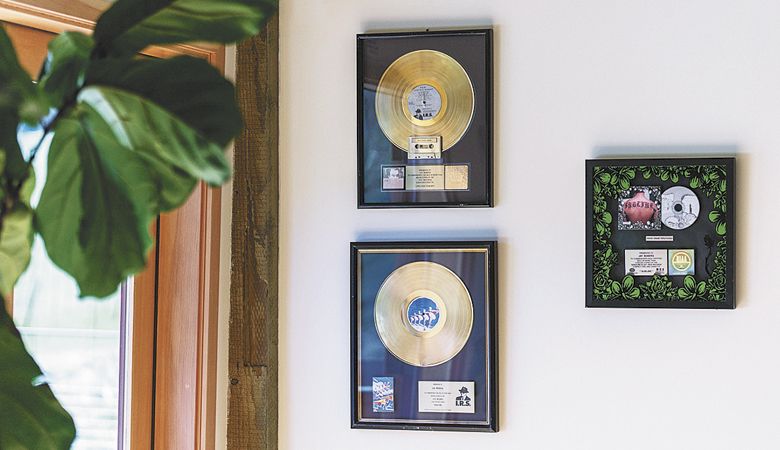Dundee Hills Headliner
Nicolas-Jay raises curtain on new tasting room
The harmonious blend of music and wine at Domaine Nicolas-Jay stems from the 30-year friendship of Jean-Nicolas Méo, a renowned winemaker from the historic French estate Méo Camuzet in Burgundy, and Jay Boberg, a music entrepreneur and co-founder of I.R.S. Records in California.
Together, they recently opened their new winery and tasting room in the Dundee Hills. The 53-acre site lies in a natural rotunda surrounded by Douglas firs and white oaks. Although they purchased the property in 2019, Boberg and Méo started making wine together in 2014 with grapes from their own vineyard, Bishop Creek, located in the Yamhill-Carlton AVA, and seven other Willamette Valley vineyards.
“So far, we have one acre of Pinot Noir, but, eventually, we’ll have 25 acres of Pinot Noir and Chardonnay,” Boberg explained. Even though the site sits on the cooler north side of the Dundee Hills, different parts of the property have southeast orientations. A relatively flat section over a ridge at 950 feet will be the future home of Pinot vines. Once a longhorn cattle farm, the property’s rich Jory soil extends six, seven, even eight feet deep in places.
Boberg has overseen the design and aesthetics of the new tasting room, a former barn transformed into a light-filled space. “We wanted it to feel like home,” he added.
Over the past few years, the two friends have hosted tastings inside a 1906 Craftsman-style house in Dundee. Boberg has been there nearly full time while developing the tasting room; Méo visits from France about eight times a year.
“We wanted to create that same feeling of intimacy,” Boberg said. “This property is a piece of paradise. We wanted the tasting room to connect to this place and its history.”
The inviting, expansive space features a full kitchen with a bar, a lounge/living room area with a wood-burning fireplace and a dining area with three 10-foot long tables for seated tastings. Its wood plank floors were milled from trees on the property, and each of the three two-inch-thick tables were crafted from a single tree sourced from the facing hillside.
Besides incorporating reclaimed wood, the tasting room shows great style aesthetic with original Thonets, chairs named for their famous mid-century designer. “Once we located them, we had them sanded and stained to match the colors on our wine labels: green for Chardonnay and red for Pinot Noir.”
Boberg’s penchant for details — and colors — explains the hours he says he spent testing and experimenting with stains for the kitchen cabinets. He wanted a definite hue of red that was refined, light and distinct. He tested different stains on different woods and, in the end, a friend suggested he try watering down the stain, which was just the look he wanted: the wood grain showing through.
Boberg’s music background is also present in the tasting room via his own speakers, some from his college days, to amplify the playlist of songs he’s curated. His music career began at age 19; over the years, he fostered some of the most popular bands of the ’80s, including R.E.M, Fine Young Cannibals, The Roots and The Go-Go’s, among others. He eventually became president of MCA Universal.
So, how did an American music entrepreneur and a French winemaker meet?
“I met Nicolas in 1987 when my sister was attending graduate school at the University of Pennsylvania,” Boberg recalled. “I was in town and called her to see if she wanted tickets to a show. She said, ‘No’ and invited me over for dinner and wine, where I met Nicolas who was also working on his master’s degree.”
Boberg was already a dedicated student of fine wines and knew about Méo’s wines. “He’s one of the top 10 makers of Pinot in the world,” he said. His family’s estate had been under the winemaking leadership of Henri Jayet, who trained Méo.
When Boberg approached his friend about a partnership, Méo said he’d like the challenge of making wine in a different region and felt Oregon was the right place. However, he wanted to make sure they could access the grapes and more importantly they needed to believe they could make one of the best Oregon wines. In 2012 and 2013, they made several trips to the Willamette Valley and tasted fruit from more than 200 vineyards.
In 2013, they purchased Bishop Creek Vineyard in Yamhill-Carlton with 9 acres of Pinot Noir and two acres of Pinot Gris — two years later, they grafted over the Pinot Gris to Chardonnay and planted three additional acres of new Chardonnay vines and another three acres of Pinot Noir.
From their initial tastings, they selected eight sites — including Bishop Creek — from which to craft wines. “The idea was to make blends. We make all the wines separate, from individual vineyards and even individual blocks. Wines go through the entire process and blending begins about 30 days before bottling,” Boberg said.
All the grapes, picked by hand, are placed in cherry bins because they’re shallower than grape bins, making crushed fruit less likely. The clusters are then hand-sorted before going into tanks. Some years, Méo drains off some of the juice from the Pinot tanks filled with whole and crushed grapes, seeds and skins, to improve what’s in the tank. The juice, called saignee, is used to make rosé.
Their flagship wine, L’Ensemble, remains the winery’s top-tier Willamette Valley Pinot. They have three single-vineyard Pinots from Bishop Creek, Nysa and Momtazi. They added Chardonnay in 2017, along with a unique wine called Own Rooted. It’s a Pinot blend of those hard-to-find older vines on their own rootstock — fewer than 100 acres are left in the state due to phylloxera, a root-destroying louse.
“We are trying to make wine that we want to drink,” he said. The style they both enjoy is one that’s balanced, and reflects the place and personality of the land. “Our partnership works because we share wine tastes; we like wine with a tension between structure and tannins, the place of elegance,” Boberg said.
In the music business, he would see bands that just “clicked” for him. People wondered how he chose them. “I loved what they were doing . . . it was music I wanted to listen to. I had the conviction they were original.
“Art is a river, not a lake, it’s always changing,” he continued. “The only way to find and develop an artist on the cutting edge is to have a personal conviction.”
Boberg feels the same about wine: “You need to have conviction. It makes a difference when you’re out in the marketplace. Buyers can sense that you really believe it’s a great wine. You don’t have that feeling if it’s just commercial.”














